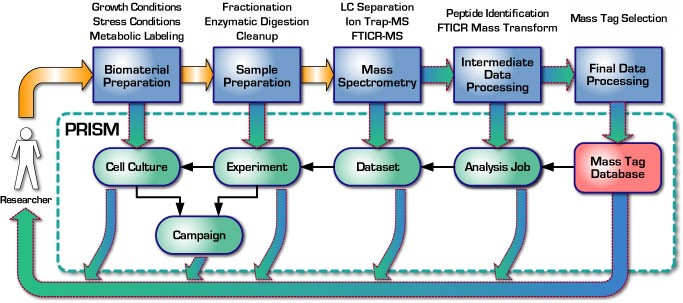About the Proteomics Facility
The Proteomics Facility processes biological materials to extract information for the identification and quantitation of the proteins component. The process includes mass spectrometry in combination with liquid chromatographic separation to identify characteristic peptide fraqments that function as biomarkers for their parent proteins. Automated data processing is used to achieve high-throughput, and an integrated data management system (PRISM, described below) provides researchers with access to information at each stage of the process.
Proteomics Facility Process

 |
| Figure 1: Proteomics process and information flow. |
Figure 1 illustrates the steps in the proteomics process and the flow of information. The blue rectangles represent major steps in the overall Accurate Mass and Time (AMT) Tag proteome characterization process and the corresponding interactions with key structures in the Proteomics Research Information and Storage Management (PRISM) System.
Researcher-supplied biological material is processed through the system to produce data representing the protein/peptide contents. Throughout the process, PRISM uses tracking entities to control and document all of the steps, allowing the researcher to monitor the sample's progress during its journey through the system. The tracking entities are arranged in a hierarchical fashion that faithfully represents the structure of the process used in the laboratory: a campaign is composed of one or more experiments, an experiment is composed of one or more datasets, and a dataset is composed of one or more analysis jobs. Mass-tag databases contain the mass and time tags and are used to compile the final results.
Accurate Mass and Time Tag Generation and Use
The Accurate Mass and Time (AMT) Tag process identifies protein biomarkers in an organism by combining raw measurements from liquid chromatographic separations and diverse mass spectrometers into correlated results. Tandem mass spectrometric analyses of enzymatically digested protein samples using tandem mass spectrometers coupled with high-pressure microcapillary liquid chromatographic separations are performed to establish a set of tentative peptide identifications called Accurate Mass and Time (AMT) tags. The AMT tags are then used to identify data from high mass measurement accuracy (MMA) mass spectrometers (FTICR-MS or Orbitrap-MS), coupled with the same type of separation system. The identification process, known as peak matching, involves the alignment of the high resolution LC-MS data to the AMT tags in the database, followed by a search for AMT tags with a similar monoisotopic mass and elution time as features detected by LC-MS (using small mass error and elution time error tolerances).
Service Requests
To initiate work with us, complete and submit the Proteomics Support Request Form. Any type of support may be requested through this Proteomics Support Queue. We will respond as soon as possible. An administrator will be assigned to your job and may contact you to regarding the specifics of your request or to obtain any necessary materials.
Service Request Status
Once a service request is made, you can view it in the Proteomics Support Queue; instructions for logging in are described in PRISMWiki.
For requests that involve new entities in DMS, Tracking Reports within DMS can be used to view the status of requested jobs. There are five primary reports (cell culture, campaign, experiment, dataset, and analysis job) which allow you to drill down into the database for further information regarding your samples, et al. Click on a PRISM tracking entity in Figure 1 to access a Tracking Report.
